I am trying to post forth arguments. I will make a post tomorrow going through the video in detail 
Never assume it’s a blanket accusation.
I am trying to post forth arguments. I will make a post tomorrow going through the video in detail 
Never assume it’s a blanket accusation.
Once you will have the time to provide the arguments it will not be a blanket statement anymore. I look forward to it.
Until then, the interpretation of what your message means is left to your fellows 
I’m not arguing for the sake of it.  Segregation in the U.S. is quite a fascinating subject, but it’s really complicated. I will put forth the post tomorrow.
Segregation in the U.S. is quite a fascinating subject, but it’s really complicated. I will put forth the post tomorrow. 
No worries, I was just doing friendly semantics here lol
Personally I wished the video covered how this segregation of the army influenced rape cases of the civilian population in occupied countries like France. A lot of French articles report that black servicemen were often used a scapegoats and executed in place of white servicemen.
And now that I could get the source back, here is an article with 35 sources for this:
https://www.cairn.info/journal-vingtieme-siecle-revue-d-histoire-2002-3-page-109.htm#no2
In french obviously, but according to them the army’s official records show that white servicemen did 6 murders, 4 rapes and 4 rapes where the victim was murdered. Black servicemen did 22 murders, 25 rapes and 8 rapes where the victim was murdered.
Obviously those numbers are not believable, there are too many rape survivors that claims white servicemen were responsible and the fact that there was not that many black servicemen compared to white (only 10%).
Disclaimer:
I have discussed this video with a friend of mine and history buff from Georgia whom I shall call JD at his request and this is what we thought of the video. We thought it would be a neutral take on segregation in the United States. Little did we realize how disappointed we would be. I won’t be discussing minor mistakes, like his pronunciations of certain names, because the content matters more here.
And at the end, I would suggest improvements to the video (this entire post should honestly be considered that). This is no libel intended for Sparty or anyone who worked on the video here.
We expected better.
From our perspective in 2021, WWII might be framed as a war against racist powers.
Why? This is a pet peeve of mine, when people talk about history from a modern perspective. Tell it as it was from 1940s eyes (no matter how different the world is now). That’s why I transcribe wartime news articles for the forum. And yes, even in 1942, it was seen as a war against racist powers, just not like in 2021.
But, we all know that racism is, and was, not a thing exclusive to the Axis.
JD initially thought it was a fallacy.
If you frame WWII as a war against racist powers… and affirm racism is not exclusive to the Axis… then the U.S., and its Army, must be racist.
Just felt like a potential fallacy to me. It’s not. But, his opening line made me want to go back and look at it again.
It’s fair to say that, in this war, in the 1940s, there is a huge difference between the racism among the Allies and the racially or ethnically genocidal character of the Axis conquest. Their waves of mass murders are, in many ways, unprecedented.
JD said:
Ok. Not really “unprecedented.” History is full of racial and tribal ideology and genocides, but ok.
Among the United Nations’ Allied countries, a few stand out by not only being racist, but even being powers founded on the premise of racism and exceptionalism. The Netherlands, Belgium, the United Kingdom and her Commonwealth, and France are colonial empires rooted in systemic racial inequality.
“Founded” on the premise? That’s quite the leap there.
To create these empires they had caused massive death among indigenous populations, and they continue to exploit their colonial subjects for economic gain.
JD:
Interesting that the video then proceeds to show picture of the Amritsar massacre for the former which was controversial even among pro-Empire folk in 1919. The Belgian Congo was also just as controversial then, but I personally feel that would’ve been a better picture to show.
JD had a few issues with the use of the word “colonization”:
I guess what I’m trying to get at is, imposing governmental will is not “colonization.” I’m griping a bit that every action during the age of empire is classed as that. Otherwise, would you say that Napoleon was “colonizing” Europe? I think not. Now, what’s funny when you think about it is that Hitler was indeed colonizing.
I had a few disagreements with JD on this point, using Australia and Canada as examples. But that is a good point he made.
The United States itself, originally a union of colonialists, has also fought racially-motivated wars; including genocide against the Native American population, exploited perceived inferior races through slavery and colonized overseas territories to expand their global power.
JD:
He goes into autopilot parrot mode for about 3 minutes there.
The U.S. was a union of former colonies (though the use of the term “colonialists” is rather strange). We did have a colonial mindset though, wanting to push inland and control the continental destiny.
The Indian Wars were not “racially-motivated” though… that framing is entirely false. We didn’t fight Indians just because they were Indians. It’s way more complicated than simply putting a blanket description of it being “genocidal.” Indians fought on both sides of the Wars and it was motivated more by land than by race. Even when you consider President Jackson’s actions. I’ve even noted comments in Sparty’s video calling him out on that.
JD is from Georgia, mind you. And he explained to me all the complexities behind the Trail of Tears. Maybe I would post 'em soon if the opportunity comes.
Meanwhile, African-Americans, especially in the Southern states, are still second-class citizens under the Jim Crow laws.
More complicated than it appears on the surface. Not every state had Jim Crow laws and even in the states that did have them, the laws often varied.
Many Germans speak of a “Jewish Problem”, many Americans about a “Negro Problem”.
No, just no. That’s just false equivalence. The final solution for the Americans was never genocide, like with the Nazis. At least that’s what I’m getting from the framing and implication that statement has.
People of color don’t have the same political, economic and social rights and opportunities.
For example, in the 12 Southern states, only 2% of voting age African-Americans are actually eligible to vote.
This is where Sparty starts quoting Donny Gluckstein, a British historian who is an admitted Marxist. A People’s History is not exactly the most reliable source to go by. JD read it and the book was just academic “circle jerking” and so lacking in nuance that even Howard Zinn would blush.
Gluckstein, Donny, A People’s History of the Second World War (2012):
JD and I noticed how, throughout the video, Gluckstein is quoted frequently, more than any other source – there are only two (probably 1½) other sources used in the video – word for word.

In the 1930s, the Great Depression has exasperated their situation with even higher rates of unemployment and destitution than other ethnic groups.

Nationally, in 1931, black men had a lower unemployment rate than whites. But, in the cities, it was worse.
Half a decade later…
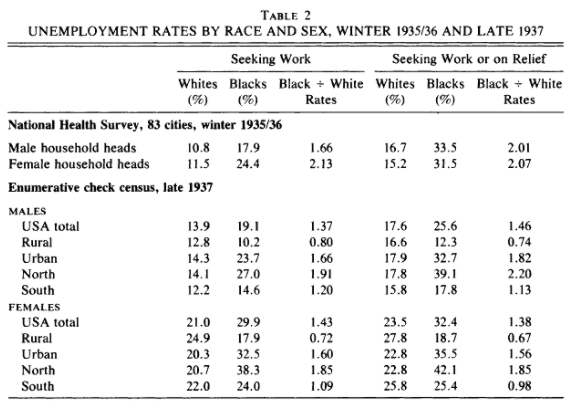
The tables are census data. The author of the Journal of Economic History goes through how the numbers were obtained and how the rules of measurement “changed” between 1931 and 1937, which makes precise comparisons more difficult. Then he goes into what he calls the “three classes of explanation for the higher unemployment rates of black workers.”
The first focuses on background characteristics and argues that even in the absence of discrimination, black workers were generally less well-educated and skilled due to their historical work opportunities and experience.
Further, the trades they did choose to develop skills in, such as carpentry, masonry, steel and auto work, were all industries that were disproportionally affected by the market contraction during the Depression.
The South, the author argues, was less affected and this view explains the relative disparity between the North and urban, as Southern blacks tend to be rural (vs North) and tend to be in agriculture, which did fine, for the most part, in the South in the Depression.
It also continues that Northern blacks, who migrated before and during the Depression, also had less time in the industry and/or with various companies and firms during the Depression. This explains why they were the “last hired” (because they physically weren’t there) and “first fired” (because companies would keep longer tenured employees who had developed advanced skills specific to the job over those who had not).
The author then goes into what he calls the “second classification” – which is that labor discrimination was the cause. He quotes a National Urban League study that cites “reports of employers replacing black workers with unemployed whites.” He explains:
That discrimination should worsen when unemployment is high is an assertion based, to some degree, on the premise that discrimination is costly to employers, so competition between firms should favor non-discriminatory practices when the labor market is tight.
When the labor market is not clearing, the costs of discrimination might diminish, because any employer of blacks could find unemployed whites willing to replace them at the same wage. Such racial displacement would appear to require that unemployed blacks be unwilling or unable to offer a wage cut sufficient to protect their jobs from white competitors.
Interestingly, he goes on to point out that a detailed analysis done by Arthur Ross (The Negro Worker in the Depression) found that the displacement did occur, but primarily occurred in trades which were considered “Negro jobs”, not industrial work. This is due to the fact that skilled labor for industrial work was too costly to replace. If a worker already knew how to operate the machinery in a profitable way, an employer was unlikely to want to replace them with an unskilled worker that would need to learn. However, relatively unskilled service jobs such as waiters, domestic servants, porters were impacted by this. But, he notes, where this did occur, it was largely in the South.
Further, he found that in industries where blacks had gained employment, such as steel, coal and auto, they tended to protect the jobs with furloughs instead of discharging employees, mostly due to union contracts.
He continues that in the South, since there was a concept of a “Negro job,” these jobs were actually protected from white labor competition – a concept that did not exist in Northern labor markets. Furthermore, as blacks were concentrated into certain trades and professions in the South, they had the skills and knowledge that outclassed any white labor competition. So, they were far less likely to be dismissed.
He goes on the third classification, which is that the New Deal had an adverse impact on employment opportunities for less-skilled workers. He cites that critics of the era used to call the National Recovery Act the “Negro Removal Act.” Minimum wage codes encouraged employers to replace black workers with white workers who, prior to the codes, would have been unwilling to accept the market-clearing wage.
A common complaint among black activists went so:
An employer preferring whites, faced with a mandatory and equal minimum wage for black and whites, would lay off blacks.
They wanted the NRA to have protections against this sort of action. But it didn’t. The author dismisses this though, pointing to the existing disparities prior to New Deal policies.
He continues, based on these arguments, a proper analysis should include within occupation unemployment rates. So, he went and did that too.
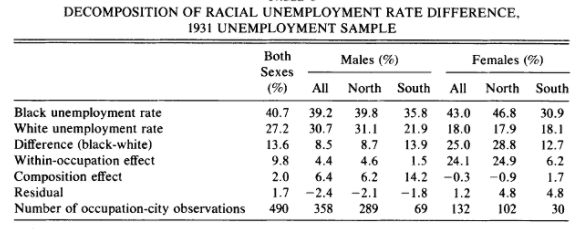
From the Cambridge Press – Journal of Economic History (1992):
https://www.jstor.org/stable/2123118?read-now=1&seq=6#page_scan_tab_contents
When unemployment drops after the massive increase in defense spending as the U.S. prepares for war, and then enters the war, they are still, largely, left out.
Most new jobs are reserved for whites, only.
Refer to the explanations above.
However, after the African-American community threatens to march down Pennsylvania Avenue in Washington, DC, President Franklin Delano Roosevelt issues Executive Order 8802, on June 25, 1941, banning employment discrimination based on race, color, or national origin.
That’s NAACP spin. It’s not false, but it’s exaggerated.
![]()

Although less unequal there than the South, they still face wage inequality, discrimination in housing and education, as well as everyday prejudice and violence.
Once again, even as I get ready to cover some infamous Northern and Western riots next year, it’s a lot more complicated than that, speaking as a Northerner.
In, for instance, Britain, in theory, black people are to serve in the war on equal footing.
British subjects from the colonies and British protected persons who are in this country, including those who are not of pure European descent, are to be on the same footing as British subjects from the United Kingdom as regards eligibility for voluntary enlistment in the armed forces and for consideration for the grant of emergency commissions in those forces.
But, in reality, black British citizens from Africa or West India and Jamaica are often held back by racial stereotypes. They are alleged to be sickly, or unable to learn quickly enough, or unable to handle modern weaponry.
The only reason Sparty put this comparison with the British in there is to set up for the controversial Stimson quote, which I will get to later in the post. A “poison pill,” as JD put it.
And JD thought:
That said, it makes little sense that the Brits would be “integrated” (which he implies) in WWI, but somehow have troubles with it in WWII?
But, the U.S. Army remains segregated to the point of being two armies – a colored and a white one.
Quoting Gluckstein again:
![]()
They’re separated by race, yes, but that doesn’t mean they were literally two armies. They still got the same orders from the War Department.
JD:
I wrote in my notes that it’s interesting he only really speaks about the Army. Because he only had one source who also only spoke of the Army.
The vast majority of colored soldiers are lower ranks with only two officers.
Gluckstein quote again.
![]()
At least name them. This was from the Army:

In 1940, the total number of black Regular Army officers was five, of whom three were chaplains.
https://history.army.mil/html/faq/diversity.html
JD:
Admittedly not the best source, considering it’s a diversity officer, but it’s still a military source.
The relegation of the active-duty black units to housekeeping chores increasingly left the interwar Regular Army with a cadre of black non-commissioned officers who excelled at garrison duties but who lacked the experience to train and lead new recruits during wartime. This was what the 1922 and 1937 Army reports were talking about – they knew at the time this was a problem. Basically, the 1922 plan wasn’t achieved and that ended up causing a big problem they were aware of. I will discuss those plans and reports later in the post – they are really important.
Also, from a military angle, some of the stuff he talks about is just silly. The question for TG is to please define “lower ranks”, because, in a whole lot of the pictures shown throughout the video, they had more than one stripe.
The vast majority of any army is “lower ranks” – otherwise it won’t function.
The National Association for the Advancement of Colored People (NAACP) and the National Urban League continue to argue for black men and officers to be assigned based on merit and not race, more colored officers, access to the Air Corps, and a say in the selective process.
Sparty’s not generally wrong here. NAACP (mostly) and the NUL pushed for the creation of the units and pushed for more “prestigious” units (for the Air Corps) to be created. But the order wasn’t passed strictly because of them, which you will see later. And, remember, they were and are activists. They had and will have exaggerated the role they played, folks like William Hastie in particular certainly exaggerated.

The share of black servicemen does increase, so that by late 1942, 468,000 African-American soldiers are enlisted.
But, as a relative share of the Army, they will never surpass 5%, still only half of the share of the population. An end to segregation, it will not be.
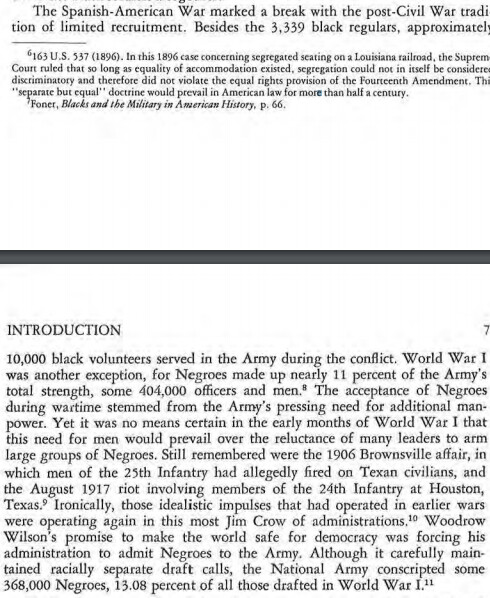
If blacks constituted 13.08% of the Army in WWI, why would they “never be more than 5%” in WWII? Well, here’s the answer:
Remember the reports I mentioned earlier? Well, here they are!
Here are some good sources that the video should’ve used, courtesy of JD:
There were two interwar doctrines dealing with race. One articulates, for example, that black units must be used in combat as well as service units.
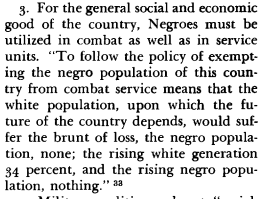


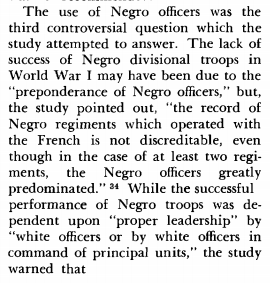
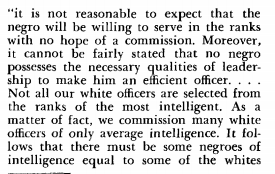

JD:
Interesting to see the bigotry of low expectations being challenged even then. Basically the report said, “If you think blacks will join without the opportunity to be officers, you’re being stupid. And if you point to poor black officers in WWI, that’s because you lowered the standards and promoted bad officers, not because blacks can’t make good officers.”
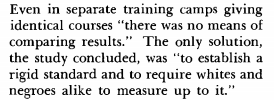
The '22 plan required:


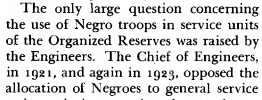
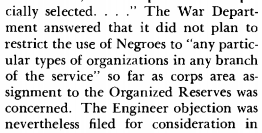
Remember this from earlier in the video?
In 1939, out of around 174,000, only 2% – or 3,640 – are black, while African-Americans make up close to 10% of the population.
JD:
Having it being less than 2% doesn’t really make much sense unless something big happened in 1938.
This was from 1931:


10.73% in 1931.
What changed by the late 1930s was simple: people left the Army. Though, it should be noted, this includes National Guard units. And, there’s a problem there.

The 1922 plan left the National Guard units up to the states, and only forced unit creation in the Regular Army. And many states did not create black Guard units. Or, if they had them, they were limited. The report done in 1937 articulated this was a problem, because even when blacks tried to volunteer, there were no peacetime slots available. Another issue was that, because of this, blacks stopped enlisting. The Army was not seen as a career path for them, because their chances of being accepted were low. So, what the report in 1937 looked at, among other things, was that this created a major issue if they were to have a mass deployment, like in 1917.
Because, if they have to mass deploy with a draft, it means they have to draft, percentage wise, more blacks than whites. No one liked drafts and the Army knew this. So, they tried and mitigated the impact in their mobilization plans. They absolutely had to plan for it. Basically, their concern was social pushback if, all of a sudden, 90.55 blacks are drafted for every 9.45 whites. Yes, really.
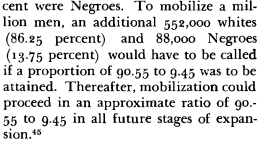
So, they wanted, desperately, to get more blacks into active duty service so that this wouldn’t happen. That was one of the issues addressed in the 1937 plan.
Back with the officers, not only did the 1922 plan require that Negro units have Negro officers, but the 1937 plan took it further by requiring Negro units to have 50% more officers.
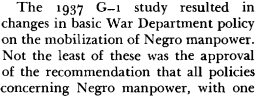
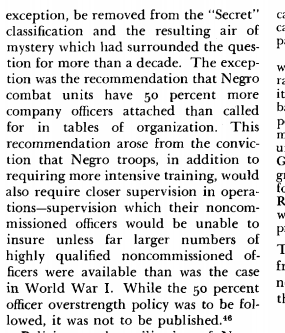
His “never reached 5%” statement is likely wrong, though likely based on this. Even in the 1940 PMP (Protective Mobilization Plan), the unit list was 5.81%. The Army target was 9-10%.
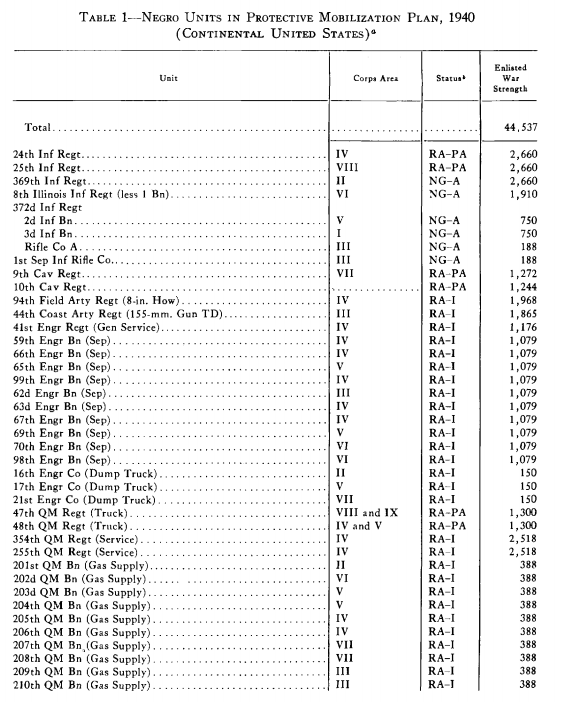
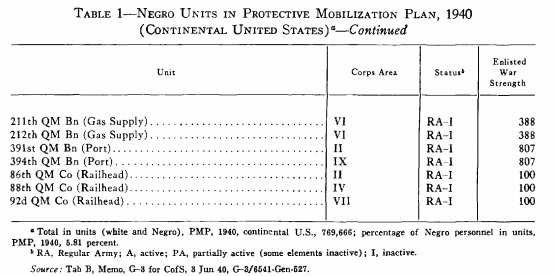
6 National Guard units and 6 Regular Army. That’s it. This was a problem, according to the 1937 plan.
Instead, their units are formed on basis of race, like the colored-only 99th Fighter Squadron and 332nd Fighter Group, stationed at the Tuskegee Airfield from mid-1941 onwards, and led by the African-American Colonel Benjamin O. Davis Jr., who will eventually rise to the rank of General and be instrumental in the racial integration of the U.S. Armed Forces.
Now with the Tuskegee Airmen, these were the origins:
The 1937 plan articulated that Negro units were to be established for the Air Corps and Signal Corps. It’s possible that pressure from the NAACP accelerated the process, but it was already on the table when they started campaigning for it. Personnel and War Plans were the ones who pushed back against it – or, for it, when you think about it. They pushed back against a minor recommendation that the units not be created.
The Chief of the Air Corps, in his memos, commented that the issue wasn’t that they were black. It’s that the way the bill authorizing the Air Corps (and funding it) specifically stated the Air Corps cannot train blacks. Rather, Negro pilots were to be trained by the Civil Aeronautics Authority. He also articulated another “social problem” in that pilots were officers. So, by default, having black pilot officers outranking enlisted white mechanics was an issue.
His recommendation was to start the training of necessary enlisted men to be competent mechanics but warned that the process would take years (and it did). So, this was the genesis of the Tuskegee Airmen.
In summary:
The Army was considering it for years.
There was a lot of support for moving in this direction, they were just having trouble figuring out how.
The seeds were planted long before we saw fruit (which was exactly what the Chief of the Air Corps said would happen).
Asian-Americans will serve in segregated units like their African-American countrymen.
Oh, they segregated Japanese-American units, either for combat in Europe or as translators in the Pacific. Other Asian-Americans, like those of Filipino and Chinese descent, were integrated.
Even in the Philippines, where most soldiers are Philippine-Americans, the units remain segregated.
The Filipinos were volunteers to that segregated unit. If they did not volunteer or request that unit, they were assigned to regular white units. They asked to be segregated. Furthermore, elements of the Philippine Army that were stranded in the U.S. after the invasion of the Philippines by Japan were assigned to the unit. Fluency in Tagalog was a requirement. There were some ugly incidents though, with a few civilians mistaking them for the Japanese.
http://www.militarymuseum.org/Filipino.html
While Hispanic-Americans are, technically, considered white and part of the non-colored units, a few of them will also complain of harassment because of their ethnicity.
Private First Class Norberto Gonzalez, a Cuban-born New Yorker, finds himself at the butt of incessant discrimination in his all-white battalion. His trials and tribulations only end when he is transferred, on request, to an all-black unit, where he will later state that he was welcomed and immediately integrated.
Here is the actual story, from the man himself:
https://voces.lib.utexas.edu/collections/stories/norberto-m-gonzalez

This man’s testimony was pretty vague (being “treated differently” could mean anything), but it was twisted to make it as if he was being harassed 24/7, which was just not the case.
Here are some stories this video should’ve used instead:
Corporal Alfonso Rodriguez, a Mexican-American born in Santa Fe, New Mexico, said that he first experienced racial discrimination during recruit training. A white soldier once demanded that the Rodriguez and other Latinos stop speaking Spanish and speak English, “like Americans”, and Rodriguez was involved in several physical altercations stemming from the incident. Rodriguez was also often referred to using racial insults such as “smartass Mexican.”
Private First Class Raul Rios Rodriguez, a Puerto Rican, said that one of his drill instructors was particularly harsh on the Hispanic and black soldiers in his unit during his basic training at Fort Bragg.
Private First Class Felix Lopez-Santos, another Puerto Rican, said that he observed some racial discrimination against African-Americans, but that he never experienced discrimination himself because of his light eyes and fair complexion.
I know, Wikipedia (it also misinterpreted Pfc. Gonzalez’s story), but I have talked to folks who did corroborate these other stories:
There, on the front lines, these colored units are rarer than you might think. You see, 80% of all black servicemen will never leave the United States. Partly because other members of the United Nations, such as Australia, request the U.S. to not send too many people of color to not upset the white population.
So, what he said about Australia isn’t untrue. The Australian government, in Dec. 1941, asked that the U.S. not send blacks. The U.S. basically responded with, “Screw you, we’ll send who we want.” And the Aussies backed down, though they did establish zones for the blacks to minimize contact.
On January 25, 1942, General Barnes informed Washington that Australia no longer had any serious objection to any type of American servicemen being posted there.
This article goes on to list several Army memos where high-ranking officers were commenting about White Australia (not in a good way either, they hated it).
Also, regarding that 80% number, according to the Army, they were ramping up the number of troops to prepare for the invasion of Japan. They had already sent the units for Europe they could, but they didn’t have the forces for Japan ready yet, so there was a surge right towards the end of the war. Of course, we bombed our way out of needing them. The problem with figuring out exact numbers is the presence of draftees. The draft was only for 18 months of service. So, during the war, you had “cycling.” Therefore, we don’t know the exact percentage.
Partly because white officers are opposed to have units of colored people in their ranks. Instead, the vast majority are converted into non-combatant units.
The non-combatant comment he makes here is both false (we know they fought in combat and were deployed) and also not a good understanding of the military where the vast majority of roles were and are logistics and support, not combat. This is still very much the case today.
When asked to justify this policy by a Representative to Congress in 1943, Secretary of War Henry Stimson would reply that:
Negro units have… […] …been unable to master the techniques of modern weapons.
That’s not what he said. That was a quote from William Hastie (who was not a Congressman, he was Stimson’s civilian aide) in a 1972 interview…
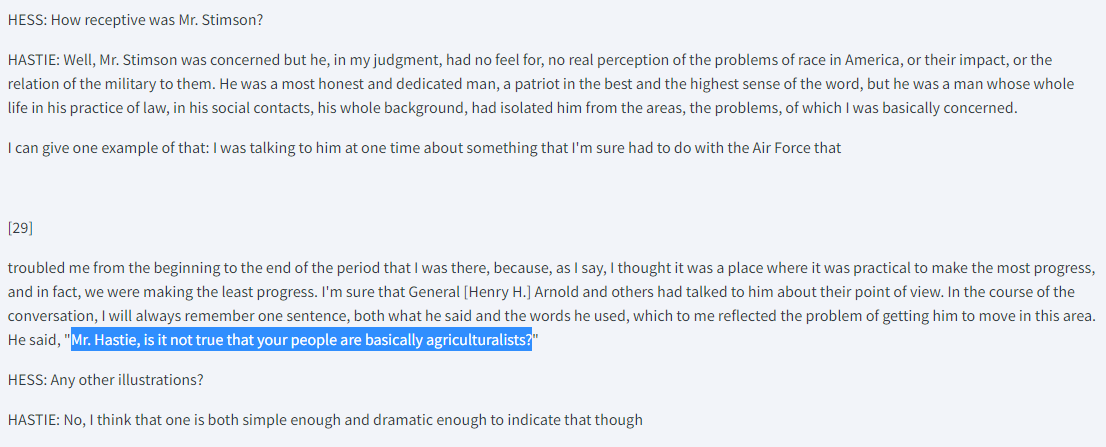

…not Stimson himself…
![]()
![]()
…that was sensationalized and twisted quite sloppily:
Wynn is another British historian and this was his only published work (outside of essays for journals).

Gluckstein again:

The second part of the quote was sensationalized by the NAACP, through Hastie and Truman Gibson. Hastie actually stepped down as a civilian aide to Secretary Stimson because he claimed that they were planning a separate OCS for the Air Corps and he wasn’t informed. The Air Corps denied the claims, but he said they were lying, and resigned. Part of Hastie’s resignation letter, published on the Chicago Defender:

And now we know where the “[…]” comes from. It’s because it was two things attributed to him, but not definitively said by him that JD and I could find, yet.
Regarding the second comment about “not knowing how to operate modern weapons,” Hastie’s big push wasn’t for ground combat. He wanted (not wrongfully) blacks to be represented in artillery, mechanized divisions, and most important to him, the Air Corps. So, the soft implication of the phrase, when spoken out of context, is that “black people can’t even use machine guns,” when Stimson could have been (and this is conjecture on our part) referring to the fact they didn’t have the education level to handle more advanced mechanized weapons, which require training and a certain level of basic education to use.
Even then, with context of the whole discussion (and considering Stimson did sign off on multiple mechanized all-black units), Stimson couldn’t have harbored that as a universal belief.
So, it’s easy to presume he may have been speaking about mass mobilization of “all blacks,” not just the higher-educated or capable ones. This does tie into racial (and regional) disparities in education.
The NAACP, following W. E. B. DuBois’ lead, really had and has a very bad habit of presuming that “anything one white man can do, all black men can do.” There’s a reality that “white militaries” learned a long time ago – some people really are just bullet fodder and they are useful. You give them a rifle, you give them some training, you point them at the enemy. But, that is “beneath the black man” in some views on the other side.
We will never know whether Stimson himself actually said that, because he died only 5 years after the war ended.
Now, African-American reactions vary.
Some have a hard time mustering up the needed patriotism to fight with vigor for a nation they feel they are not welcome in.
Why should I shed my blood for Roosevelt’s America… for the whole Jim Crow Negro-hating South… for the low-paid, dirty jobs for which Negroes have to fight for the few dollars of relief and the insults, discrimination, police brutality and perpetual poverty to which Negroes are condemned even in the more liberal North?
Quoting Gluckstein again.
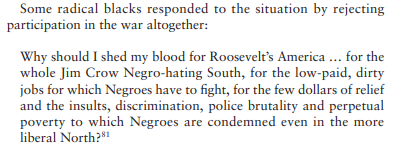
Also, some of the photographs used don’t paint the picture the video wanted to show:
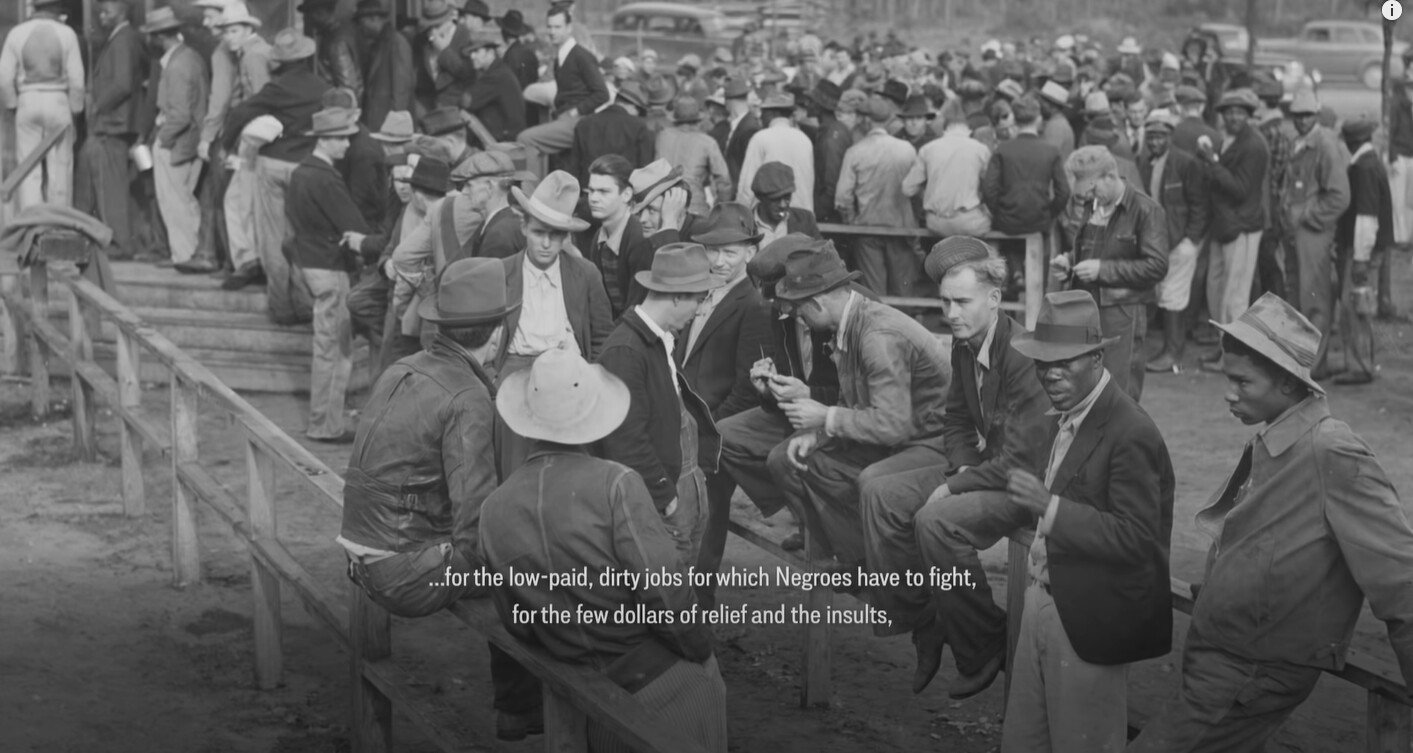
Also, this was a Communist Party rally:
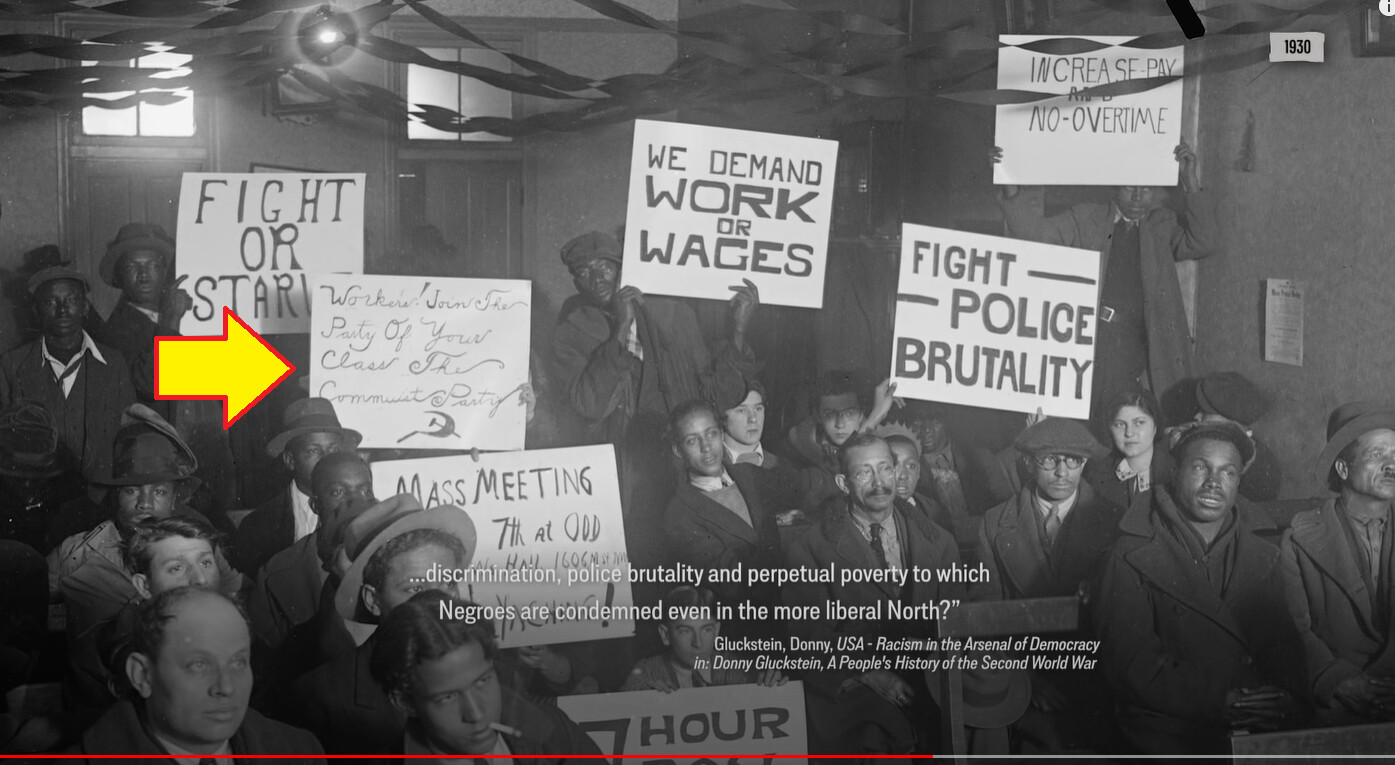
Back to the NAACP, they did make a provision for the “civilian black organizations” that were “causing pressure.” The NAACP might have stated it was a positive move, but it really wasn’t. The last thing a military commander wanted was “troublemakers” and the NAACP (and Co.) were just that to the Army. They had high demands, but weren’t interested in discussing the reality of the situation or the details, so what ends up happening was that you had dissatisfied troops.
The segregation inside the Army has some strange side effects. Like, when one black soldier notes that a white German prisoner-of-war at his encampment has more freedom of movement than he does. And, that the prisoner is allowed to ride at the front of the bus, while he, a uniformed U.S. soldier, has to sit in the back.
What’s the source? Seriously, what is? Gluckstein again?

And, to be clear, these are not isolated incidents, but the rule across all stations, with, once again, the conditions in the Southern states being at the bottom of the list.
He’s implying that every post had some sort of racial strife attached, which was just not the case.
One serviceman writes to the NAACP, Camp Stewart in Georgia:
Please for God’s sake, help us. These old southern officers over us have us quarantined like slaves come down and see… They really hate Colored. Please appeal to the War Department about our treatment at once. We are no slaves.
Others write of unspeakable sanitary conditions and multiple fatalities due to lack of medical care and riots.
Why quote Donny Gluckstein again?
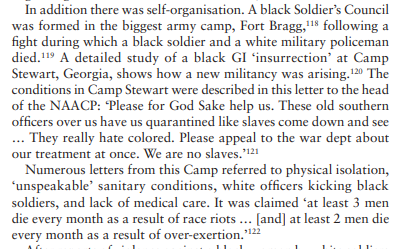
There’s far more to this than was written in A People’s History, and, as alluded to many times in our analysis, the video pretty much quoted A People’s History exactly. It wasn’t just one side being “ignorant and backwards” and the other being sweet little darlings.
At least Gluckstein mentioned the Camp Stewart riot (albeit in an oversimplified way).
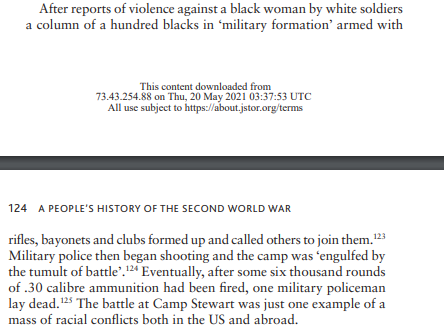
And, from the sources I put forth earlier, he missed this. Here’s the summary that was given to white commanders that were to have black units in their command:

Whichever way Sparty would want to talk about it, this is the source he should have used, instead of that Marxist historian. This pulled no punches, though I would say you could describe “white trash” in a similar vein with that summary.
JD:
The issue with the Marxist style is that they’ll find one incident and pretend it’s the rule. Or they’ll look at something that supports their underlying message of activism, and exaggerate the role played. I mean, they have to. It’s how they get funding. NAACP needs “wins,” otherwise people won’t donate to the NAACP.
Regardless of all of these hardships and the opposition to racial integration, by the end of the war, roughly 1 million African-American troops will have served in the U.S. military, out of which around 125,000 will see active combat duty, and out of them, 708 men will give their lives to fight the Axis. The war proceeds, practical reality starts to overtake ideology. And, the men serving side by side with their white and brown brothers will help fulfill at least some of the goals of the Double V campaign.
https://catalog.archives.gov/id/531415
That’s Lt. Gen. Joseph T. McNarney, Deputy Supreme Allied Commander, Honor Guard of MPs during his tour of the Fifth Army front at the 92nd Division Sector.
JD:
So, basically, they missed some really good storytelling here. This first picture is not that big a deal. It’s an honor guard. This idea that black soldiers were “invisible” is proven nonsense as that’s a Lt. General and theater commander inspecting them and they were chosen to be that honor guard for his inspection.
Interesting story with the second picture:
https://www.nps.gov/museum/exhibits/eise/Military/WWII_normandy_VEday/NARA111-SC-202330_AfricanAmericans-111-SC-2.html
The third picture is of POWs taken by the Germans:
https://history.army.mil/html/topics/afam/aa-volinfreps.html
A big missed opportunity to have not mentioned this, a massacre of black POWs by the Germans overshadowed by Malmedy:
Starting in 1942, the 332nd Fighter Group of the Tuskegee Airmen becomes the only colored airmen to see action during the war.
The 99th Squadron saw action as well, in North Africa and Italy.
By that time [when EO 9981 was signed], most of the servicemen will have been discharged to return home. To homes and cities and towns and countrysides that is still, largely, segregated. For them, personally, their service and sacrifice will largely go unrecognized.
Isn’t that revisionist lecturing about how put down and unrecognized all or at least the majority of black soldiers were for years? They had the same benefits as white soldiers and the colored men who died in service were treated with the same respect afforded to white men. The Isaac Woodard case wouldn’t have garnered national attention in 1946 if they were truly “forgotten.”
JD:
Gen. Patton’s not buttoning this man’s shirt here:
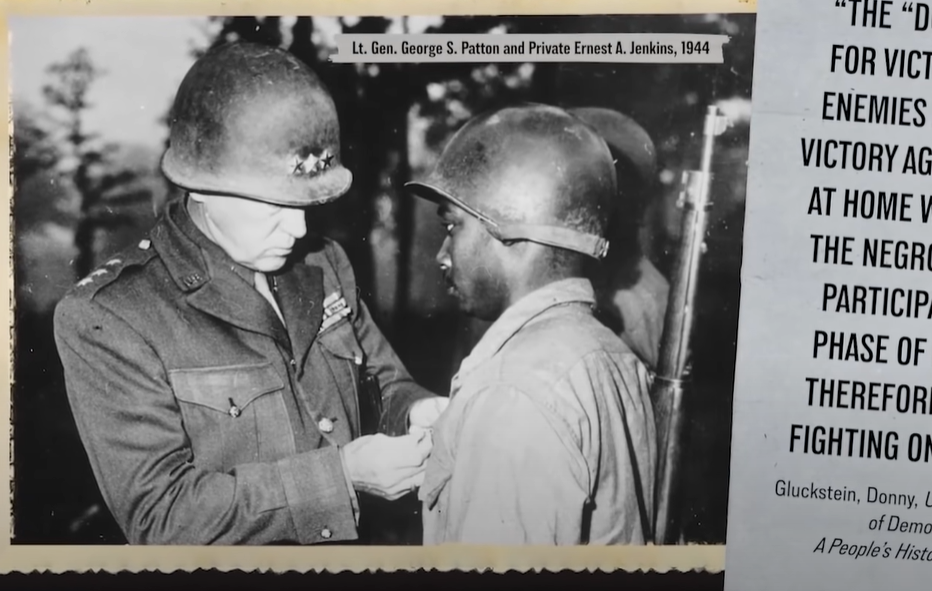
But, what’s truly bothering is that he segways from this into the Tuskegee Airmen, and then spends the rest of the video talking only about them. He doesn’t talk about the other units, even though pictures of them are shown throughout the video. He talks about the famous one that has had multiple movies, history specials and political attention drawn to it. Being a bit more casually aware of the contributions made, and the fact he sourced all these other pictures, just seems a bit silly and contrived.
Or, as one of the Airmen, Theodore Lumpkin Jr., will say near his 100th birthday in 2019:
The Tuskegee Airmen were not recognized after the war. People didn’t believe us when we told them what we did, and our work wasn’t documented anywhere.
This quote is used multiple places, but actually comes from a 2011 interview given to the Veterans History Project of the American Folklife Center, not his 100th birthday.
He was speaking about how the organization he helped craft, the Tuskegee Airmen, Inc., was important (1:28 or so in the video).

He spoke very well of his experience after the war and in the military.


https://lite.cnn.com/en/article/h_cd4aa0295e4002e19b80923c6c1225b1
But, they will have made an impact, inspiring others to follow and take up the fight.
The video shown when he said this is from a documentary on the Airmen produced by the Army in 1945, narrated by Ronald Reagan. So much for the lack of documentation and recognition.
Or, as President Barack Obama, then a U.S. Senator, will state in 2007:
My career in public service was made possible by the path heroes like the Tuskegee Airmen trailblazed.
That quote was from a written press release by his Senate office regarding the awards ceremony, which he didn’t attend.
https://www.c-span.org/video/?197394-1/congressional-gold-medal-ceremony
This was also the same day that Obama was endorsed by Jesse Jackson, implying a political slant to his statement.
In 2007, the Tuskegee Airmen still alive will finally see their service publicly recognized with a Congressional Medal of Honor.
It wasn’t a Medal of Honor, at all. That is a military award. It was a Congressional Gold Medal.
https://georgewbush-whitehouse.archives.gov/infocus/veterans/tuskegee/index.html
They weren’t even allowed to keep their medal. It went to the Smithsonian and they got bronze replicas instead.
In 2009, Lumpkin, and several of his fellow servicemen still alive, will sit in front rows at an event that, by their own statements, they never believed would happen – the inauguration of the first African-American U.S. President.
They were invited by Dianne Feinstein, not Obama (though he signed off).
They were given access to the 30,000 seats in the terrace area. Still pretty close, but not the inspirational picture implied.
http://www.aviatorspost.org/WilliamWheelerProfile.htm
I’ll give Sparty this though: They were certainly inspired and pleased by Obama’s win.
However, that’s not an excuse for the video to turn fully hagiographic in the second half. That’s just something one expects from a Lifetime movie, not a history video.
JD:
Everyone knows of the Tuskegee Airmen and if they want to do a special on them, fine. But, I find it quietly amusing that they pick the “white-approved black story” to tell. Because all people ever talk about is the Airmen when it comes to this topic.
Again, how many movies and specials have been made about them over the decades?
I’m more interested in the engineer battalions. No one ever talks about them.
Use better sources. Don’t just source a single British historian who is an admitted Marxist. Use sources closer to home and those sources that do not have the intent to rile up people into a frenzy (academia has a bad habit of doing that, especially in recent years).
Use more sources. The U.S. Armed Forces have their own historians. Their sources are excellent for a history video like this.
Post your sources in the description, always. In the video description, only the pictures are sourced. The sources for the content should also be added.
Caption the pictures correctly.
And, to quote a certain historian on YouTube, let history speak for you (very much a hypocrite himself, but that doesn’t detract from those important words).
And to the TimeGhost forum members, please take care to go through all the sources I have listed here, even the ones you would disagree with. ![]()
Thanks! ![]()
Thanks for sharing another wealth of information 
Gosh Norman, this due diligence is much appreciated!!
Very impressive ceremony. Which never made the media here in NL.
Very touching speeches. Especially how at 1.01 Democratic Senator Robert Byrd West - Virgina (with walking stick) eagerly shook hands with the Tuskegee airman.
In WW2 Robert Byrd was not in the military but a member of the Ku Klux Klan who worked as Kleagle (recruiter) an rose up to Exalted Cyclops (leader of a chapter of these murdering idiots). Obama chose to never condemn his past. That’s politics for you.
But while we can’t read Byrds mind it is still a massive shift from the 1940s when the same pilot might have swinging on a tree from his gang.
In the Netherlands his background never made the media altough they used his footage with, the narrative was democrats =good(Byrd?) Republicans (Lincoln?) is evil.
The real history is much more complex.
The IG account @ww2_day_by_day currently has a post that outlines the so called ‘Townsville Mutiny’ in Australia. The claim is made that on May 22 1942, many hundreds of black troops rioted and turned machine guns on white officers-many people died according to the post. The US ‘coverup’ the whole thing, but the event was ‘uncovered’ by Australian Historian Ray Holyoak way out in 2012 and he got much publicity for his efforts-a truly amazing accomplishment!!..
Apparently no record of this incredible ‘event’ exists with the US Army and no military trials for murder or anything else associated with ‘event’ are on record. But wait, Roy Holyoak has not given up!-in March of 2021, he set up a gofundme for 40,000 AUS so he could travel to the US, do research and finally put an end to this mystery!!! The link is here: FUND RAY HOLYOAK
I hope this ends ok for all of us. 
Only one death was somewhat reported in the incident, iirc.
Here’s the story of the mutiny (consider this an extension of my America at War thread  ):
):
https://www.ozatwar.com/ozatwar/riotupperross.htm
I can’t help but also question whether this event was somewhat overshadowed by a murderer among our troops – Ed Leonski.
Norman, thanks for sharing. At the very bottom of that info in ‘acknowledgements’ is states the Roy Holyoak was part of providing this information on the attack.
Mr Holyoak, 9 years on, still does not have definitive proof of his assertion of a mutiny or how many people died.
I smell BS.
Come to think of it, it’s been 9 years and I have yet to see the actual report.
Whenever I do a search on the incident, it’s always news articles from 2012 purporting to said reports of the incident.
If any of you have the actual report, please share it.
Precisely, 2012 only. Holyoak’s gofundme that I posted above requests money so he can come to the states and ‘investigate’ and find the truth.
BTW is 2012 with the first black president of the US in his first term, you think Mr Holyoak would find accommodation of his requests at the US Army.
From the Pittsburgh Press (May 21, 1942), on the Navy situation:
I can’t believe I missed this in my initial post, because it’s a pet peeve of mine. I really dislike the term “people of color”. Not only grammatically questionable, but it seems as if the video was trying to be politically correct (which historians should really stop doing). Just like the content of that video. 
I may be old-fashioned, but “blacks”, “colored people,” and even “Negro” are just fine imho.
All good points Norman.
In this post, I really do like your ‘My Suggestions’ for TimeGhost- apparently they needed reminding that history is not malleable and modern politics have no place in it.
I don’t totally, the balance and checks in the 14 points had the goal to prevent another war
Apart from illogicalities it makes for a moving target as politically correct alternatives became politically incorrect. If you go that road any publication runs the risk of cancellation.
History belongs in its historic timeframe people are smart enough to understand that language changed over time, even if they pretend not to. ![]()